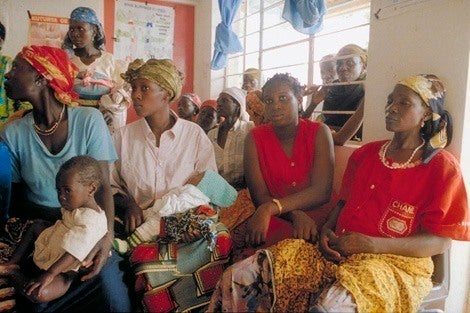December 1, 2014 — To stem the spread of HIV among women in Sub-Saharan Africa and to boost their overall health and the health of their families, it’s crucial to improve not just HIV care but also reproductive and maternal health services—and to knit the services together—according to a series of new papers in the Journal of Acquired Immune Deficiency Syndromes (JAIDS).
The 13 articles in the supplement, published online December 1, 2014 to coincide with World AIDS Day, were co-edited by four faculty members at Harvard School of Public Health (HSPH).
While reproductive care, maternal care, and HIV care are frequently siloed, evidence from the new articles suggests strongly that providing more integrated care is key to addressing the multiple needs of women of reproductive age in Sub-Saharan Africa, where the HIV pandemic thrives. Of all pregnancies of women living with HIV worldwide, 90% occur in the African subcontinent. And in some Sub-Saharan African countries the health burden is particularly high; roughly 1 in 3 pregnant women in South Africa, Botswana, and Swaziland are living with HIV.
“We will not turn the tide of the HIV pandemic, achieve universal access to reproductive health services, and eliminate preventable maternal mortality without improving the availability, accessibility, acceptability, and quality of maternal, reproductive, and HIV care and treatment for women who are living with HIV,” the HSPH co-editors wrote in an introductory article.
Co-editors—each of whom also co-authored one or more papers in the supplement—included Tamil Kendall, postdoctoral fellow with the Maternal Health Task Force (MHTF) in HSPH’s Department of Global Health and Population; Till Bärnighausen, associate professor of global health; Wafaie Fawzi, chair of the Department of Global Health and Population; and Ana Langer, MHTF director and professor of the practice of public health.
Articles in the supplement outlined several important and sometimes surprising findings. For instance, one study found that pregnant women living with HIV who share their diagnosis with anyone are almost six times more likely to use antiretroviral therapy (ART) during pregnancy than women who don’t share their diagnoses. These women are also three times more likely to give birth in a health care facility, considered essential to good maternal care.
Another study found that having a child or partner in HIV treatment reduces a woman’s risk of dropping out of treatment by 50%.
Kendall and the other HSPH co-editors also noted in their introduction that, even though there are national and global policies calling for integrated care, there’s surprisingly little evidence about the outcomes of such programs—so a key priority for the future is to study such integration further.
“The articles in the supplement can be used as a road map for research and practice,” said Kendall. “They provide useful empirical evidence for policymakers and practitioners to be able to take those next steps toward integration—and to evaluate those next steps—so we can continue to learn from what’s happening on the ground.”
Other HSPH authors of papers in the supplement included Donna Spiegelman, professor of epidemiologic methods; Christopher Duggan, associate professor in the Department of Nutrition; and Goodarz Danaei, assistant professor of global health. Other co-authors included Pascal Geldsetzer, Dawn Foster, Nan Li, Kathleen McDonald, Ibironke Olofin, Julia Raifman, Hannah Ratcliffe, and Mary Nell Wegner from the Department of Global Health and Population; and Rebecca Hope, MPH ’14.
photo: Liz Gilbert, courtesy of Photoshare
